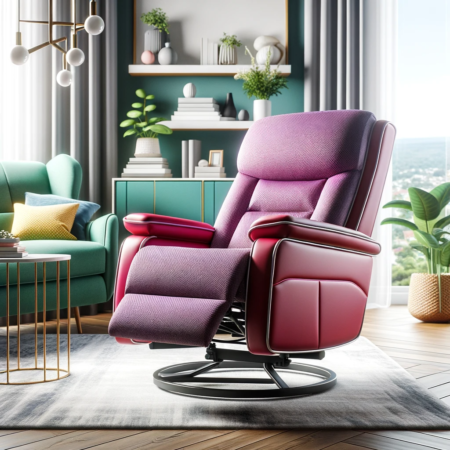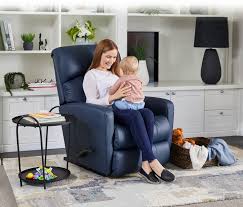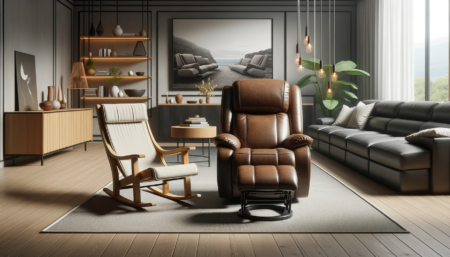Imagine sinking into a plush, comfortable chair, gently swaying back and forth as you effortlessly recline into a state of relaxation. This is the magic of a glider recliner, a marvel of engineering that seamlessly combines the soothing motion of a rocker with the customizable comfort of a recliner.
In this article, we’ll know the secrets behind the glider recliner’s mechanics, uncovering the science and design principles that bring us the ultimate in seated comfort and relaxation.
Exploring the Mechanics of Glider Recliners
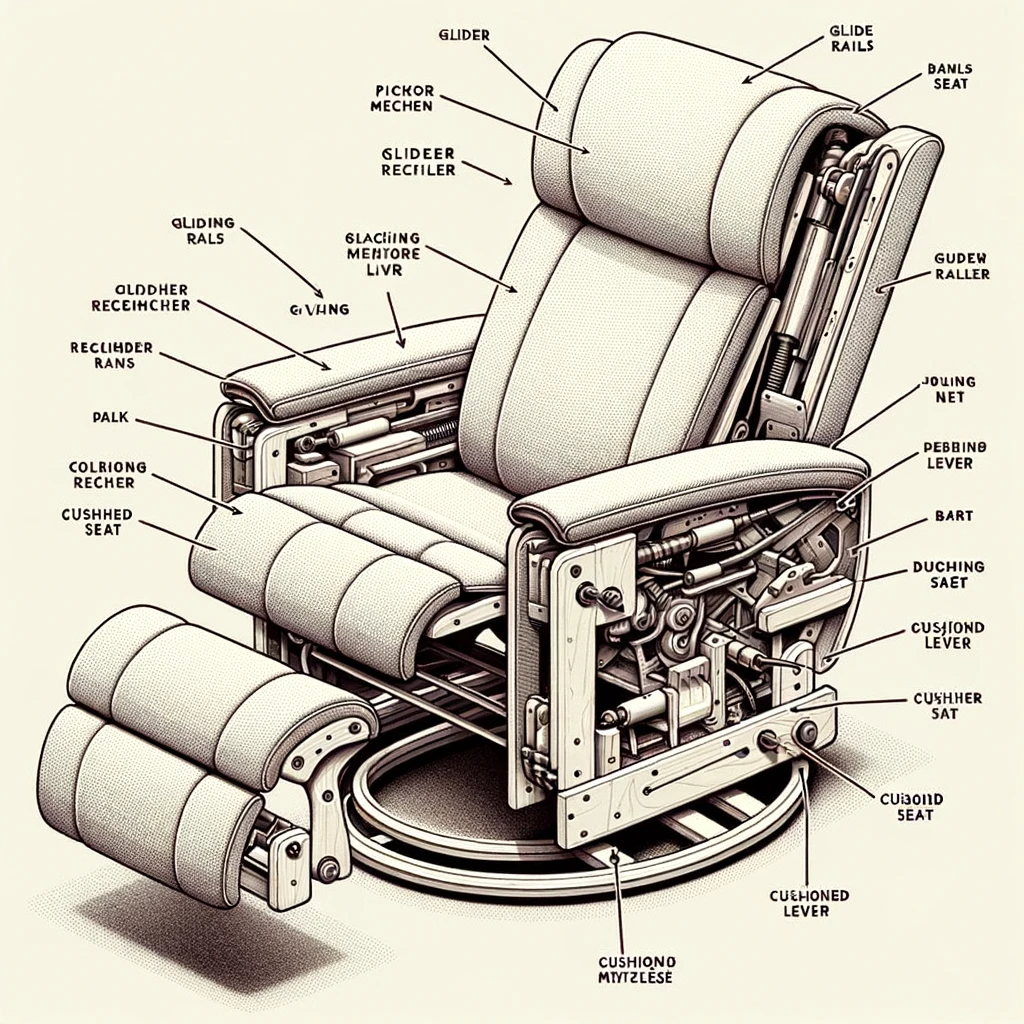
The reclining mechanism allows the user to adjust the chair’s backrest and footrest to different positions for optimal comfort. There are typically two main types of reclining mechanisms in glider recliners:
Lever-Based Mechanism
This is a manual mechanism where the user operates a lever or handle typically located on the side of the chair. When the lever is engaged, it allows the chair to recline backward while elevating the footrest.
Power Reclining Mechanism
Some glider recliners come with a motorized or power reclining mechanism. Users can control the recline and footrest positions with the push of a button, making it more convenient and customizable.
Gliding Mechanism
The gliding mechanism allows the chair to move smoothly back and forth in a gentle rocking or gliding motion. This motion is typically achieved through the use of ball bearings or bushings strategically placed in the chair’s base. The design of the gliding mechanism is what sets a glider recliner apart from a standard recliner.
Types of Reclining Mechanisms Commonly Used in Glider Recliners:
| Type of Reclining Mechanism | Description |
| Lever-Based Recliner | Operated manually using a lever or handle typically located on the chair’s side. Requires physical effort to recline or return the chair to an upright position. Simple and reliable mechanism often found in traditional glider recliners. |
| Push-Button Power Recliner | Electrically powered mechanism activated by push buttons or a remote control.Effortlessly adjusts the chair’s position to various recline angles and elevates the footrest. Provides precise control and convenience but requires a power source. |
| Wall-Hugger Recliner | Designed to save space by allowing the chair to recline while positioned close to a wall. Typically utilizes a linkage mechanism that moves the chair forward as it reclines to avoid hitting the wall. Ideal for smaller rooms with limited space. |
| Rocker Recliner | Combines the gliding or rocking motion with the reclining function.Offers both gentle rocking and various recline positions for versatile comfort. Commonly used in nursery glider recliners for soothing motion. |
| Swivel Recliner | Includes a swivel base that allows the chair to rotate 360 degrees. Enhances the chair’s versatility, making it easy to change viewing angles or access different parts of the room. Popular for home theaters and open living spaces. |
| Zero-Gravity Recliner | Designed to simulate the neutral body position experienced in space, reducing stress on the body. Reclines the chair with the user’s legs elevated above the heart. Promotes relaxation and improved circulation. |
How Does A Glider Recliner Work: Diagram

The Ergonomics of Glider Recliners
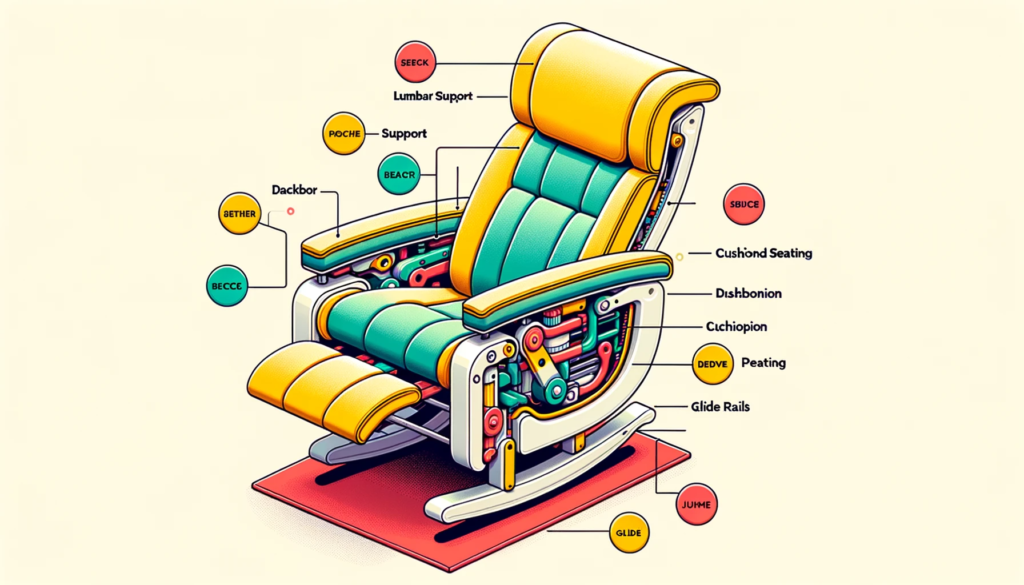
Cushioning
The heart of comfort in a glider recliner lies in its cushioning. High-quality foam or padding materials are strategically placed in the seat and backrest to provide a supportive yet plush feel.
The cushioning is designed to distribute weight evenly and reduce pressure points, ensuring that you can sit for extended periods without discomfort.
Lumbar Support
Proper lumbar support is a key ergonomic feature in glider recliners. The lumbar region of your spine naturally curves inward, and a well-designed chair accommodates this curvature.
Lumbar support in a glider recliner helps maintain the natural alignment of your spine, reducing the risk of lower back strain and discomfort.
Armrests and Neck Support
In addition to lumbar support and cushioning, the armrests and headrest of a glider recliner contribute significantly to overall comfort. Ergonomically designed armrests provide a resting place for your arms and help reduce strain on your shoulders and neck.
Adjustable headrests allow you to position your head and neck for optimal comfort, particularly when reclining. These features ensure that you can unwind and relax in a position that suits your body’s unique needs.
Seating Angles
Glider recliners are all about flexibility in seating angles. Whether you want to sit upright, recline partially, or fully extend for a nap, the chair should offer a range of comfortable positions. The ability to customize your seating angle is a hallmark of ergonomic design in glider recliners.
Maintenance Tips For Glider Recliner
If your glider recliner has moving parts or a gliding mechanism, periodically lubricate these parts with a suitable lubricant recommended by the manufacturer. This helps maintain smooth operation.
Direct sunlight can fade and damage upholstery. Position your glider recliner away from direct sunlight or use curtains or blinds to block excessive sunlight.
If your glider recliner has removable cushions, rotate and flip them regularly to distribute wear evenly and prolong their lifespan.
If you experience any issues with the reclining or gliding mechanisms, consult the manufacturer’s manual or contact customer support for guidance on troubleshooting and potential solutions.
If you have pets, be mindful of their claws and ensure they don’t scratch or damage the upholstery. Using pet covers or blankets can help protect the chair.
To Conclude
Understanding how a glider recliner works reveals the intricate blend of engineering and design that provides us with ultimate comfort and relaxation. These innovative chairs seamlessly integrate reclining and gliding mechanisms, often in both manual and power forms, allowing users to effortlessly adjust their seating position.
The mechanics of gliding, achieved through carefully placed bearings and pivot points, create the signature gentle rocking motion that soothes and calms. Moreover, the ergonomic considerations, such as lumbar support, cushioning, and customizable seating angles, ensure that glider recliners cater to our unique comfort needs.
Frequently Asked Questions
Do glider recliners come in both manual and power-operated options?
Yes, glider recliners are available in both manual and power versions. Manual models are operated using a lever or handle, while power recliners use electric motors and remote controls for easy adjustment.
Can I stop the gliding motion if I prefer a stationary position?
Yes, you can typically stop the gliding motion in a glider recliner and lock it in a stationary position. Most models have a mechanism or feature for this purpose.
Are there variations in the gliding motion of different glider recliner models?
Yes, there can be variations in the gliding motion, such as the amplitude and speed of the glide. Some models offer a more gentle rocking motion, while others may have a more pronounced glide.
Can I customize the recline angle and footrest position in a glider recliner?
Yes, most glider recliners allow you to customize the recline angle and footrest position, giving you control over your seating comfort.
